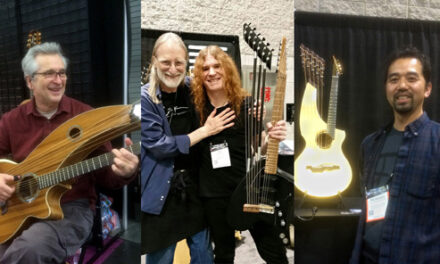That’s slang for left-handed guitar players.
We sure don’t see many left-handed harp guitars, do we? It’s not because they look really weird (though they do). I suppose it’s because there are (and have been) so extremely few left-handed guitar players (past, present, future?) willing to take up the instrument. One barrier is obviously the availability – any potential player would have to custom-order an instrument.

Of course, the original harp guitar lefty was Chris Knutsen himself. His are the only instruments where several left-handed specimens are known – and one is tempted to speculate that all may have been Knutsen’s personal instruments at one time or another. If nothing else, he couldn’t really test-drive any new designs or experiments without building himself a left-handed instrument to play on. Thinking along those lines, I’m surprised we haven’t actually found more (the first 3 of these below were played by Knutsen).

Visually, this is a whole new arena. Think about it. Looking at a standard 6-string guitar, with its figure-8 shape, you wouldn’t even know it was a lefty at all unless you got up close to see the strings, or perhaps a pickguard on the “wrong” side. Even distinctive, asymmetrical left-handed electric or archtop guitars (a Les Paul, for example) don’t look too out of place – if anything, some almost look cool.

Lefty harp guitars on the other hand look just plain abnormal. I suppose it’s because they look wild to begin with – so reversing the arm, and especially throwing in an off-center bridge, and my eyes start to water.
This is my own Dyer, flipped to show how it would be built for a southpaw. Taken on its own, it’s noticeably backward and “wrong.”

But seen in playing position, there’s a point of reference, so it suddenly looks pretty “normal.” What an interesting illusion! (the guitar, not my sudden ambidextrous transformation).
Even better, when you place a lefty with a right-handed original, like in the Knutsen family photograph below, or a pair of Gibsons (Charles Hoffman’s shot of the only lefty U known) – you get a wonderful book-ended tableau that becomes gloriously more than the sum of its parts. This is why I now recommend to all left-handed harp guitarists that they marry a right-handed harp guitarist. It’ll make all the difference!
 (Photograph from the Collection of the Jefferson County Historical Society. Used by permission. Copyright JCHS)
(Photograph from the Collection of the Jefferson County Historical Society. Used by permission. Copyright JCHS)


Other than the above, I can’t think of any historical lefties – true? Modern makers haven’t done many either. There’s this Brune instrument from way back, and of course Kerry Char early on did a left-handed Dyer commission (below). I’ve heard of a couple more in the works.

The latest entry in the “I’m left-handed, and I wanna play harp guitar, dammit!” field is Francesco Faldani, of northern Italy.

He just picked up his new lefty this week from builder Massimiliano (Max) Monterosso, who lives in Abano Terme, near Padova, Italy (I just added Max to the Luthier page). Woods are Italian spruce top with lovely black walnut back and sides.


The two shot a quick video when Francesco picked it up.
Stephen Bennett, who has been following Francesco’s progress for several years, has nothing but good things to say about him.
So Francesco – no pressure, but we’re expecting great things from our first serious harp guitar southpaw!






The reason the flipped picture of the Dyer “looks” right when it’s being played is because it’s what you see when you look in the mirror….. when you’re pretending to be Michael Hedges :o)
That black and white photo of the Brune guitar, was a guitar used by Smith Sherman (smithsherman on youtube), who – if the rumours are true – is now a luthier himself!!
Interestingly enough I found the ‘standard’ Dyer style lefties to be very easy on the eye while the Gibson version was incredibly strange to look at. Of course I find even the righty Gibson’s odd while I love the look of the Dyer’s.
Ah beauty, truly a subjective thing.
Hey, I’m a lefty, but I play right. 🙂
Don’t forget the lefty UTP Chris is pictured with in the Times photo. Also I have a feeling those “ambidextrous” harp steels were once originally made for Chris, then converted for sale.